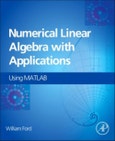Numerical Linear Algebra with Applications is designed for those who want to gain a practical knowledge of modern computational techniques for the numerical solution of linear algebra problems, using MATLAB as the vehicle for computation. The book contains all the material necessary for a first year graduate or advanced undergraduate course on numerical linear algebra with numerous applications to engineering and science. With a unified presentation of computation, basic algorithm analysis, and numerical methods to compute solutions, this book is ideal for solving real-world problems.
The text consists of six introductory chapters that thoroughly provide the required background for those who have not taken a course in applied or theoretical linear algebra. It explains in great detail the algorithms necessary for the accurate computation of the solution to the most frequently occurring problems in numerical linear algebra. In addition to examples from engineering and science applications, proofs of required results are provided without leaving out critical details. The Preface suggests ways in which the book can be used with or without an intensive study of proofs.
This book will be a useful reference for graduate or advanced undergraduate students in engineering, science, and mathematics. It will also appeal to professionals in engineering and science, such as practicing engineers who want to see how numerical linear algebra problems can be solved using a programming language such as MATLAB, MAPLE, or Mathematica.
Please Note: This is an On Demand product, delivery may take up to 11 working days after payment has been received.
Table of Contents
1. Matrices 2. Linear equations 3. Subspaces 4. Determinants 5. Eigenvalues and eigenvectors 6. Orthogonal vectors and matrices 7. Vector and matrix norms 8. Floating point arithmetic 9. Algorithms 10. Conditioning of problems and stability of algorithms 11. Gaussian elimination and the LU decomposition 12. Linear system applications 13. Important special systems 14. Gram-Schmidt decomposition 15. The singular value decomposition 16. Least-squares problems 17. Implementing the QR factorization 18. The algebraic eigenvalue problem 19. The symmetric eigenvalue problem 20. Basic iterative methods 21. Krylov subspace methods 22. Large sparse eigenvalue problems 23. Computing the singular value decomposition Appendix A. Complex numbers Appendix B. Mathematical induction Appendix C. Chebyshev polynomials
Authors
William Ford University of the Pacific, Stockton, California, USA.William Ford received his undergraduate education at MIT in applied mathematics and a Ph.D. in mathematics from the University of Illinois in 1972. His area of research was the numerical solution of partial differential equations, and the results of his work were published in three top-flight journals. After two years at Clemson University, he accepted an appointment at the University of the Pacific in Stockton, CA, where he taught mathematics and computer science. In 1986, he became a founding member of the Department of Computer Science that is now located in the School of Engineering and Computer Science. He served as Chair of the Department for eleven years and retired in 2014 as a recipient of the Order of Pacific, the highest award the University gives.
Dr. Ford is the co-author of five computer science texts and two commercial software packages. For many years, he has taught computation for engineers, discrete mathematics, and computing theory. His interest in writing a book on numerical linear algebra arose from working with graduate engineering students. There is a tremendous need for engineers to be familiar with numerical linear algebra and its applications. Dr. Ford saw the need for the subject to be taught at the advanced undergraduate as well as the beginning graduate level. Yet, most engineering students have only applied linear algebra available to them, and books in the subject only touch on numerical aspects. The basics of linear algebra are necessary before a study of numerical linear algebra can begin, but few institutions can afford to offer two separate courses. As a result, he developed a book that in the early chapters provides the linear algebra necessary for a study of how to perform accurate computation in such problems such as solving general and specialized square linear systems, least-squares, computation of eigenvalues, and the iterative solution of large, sparse systems. The book contains many computational exercises and carefully chosen written exercises. Some of these written exercises introduce methods not directly covered in the text but, in each case, the method is developed in understandable parts. The same is true of proofs, and hints are provided for the most difficult problems.








